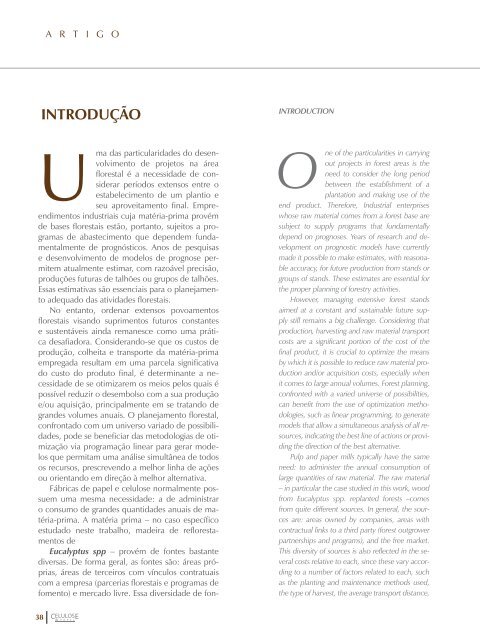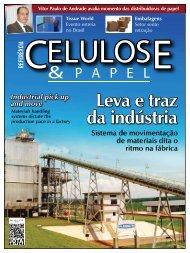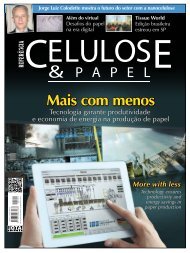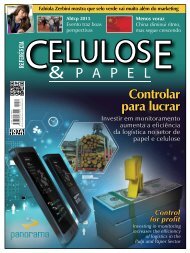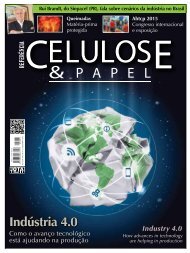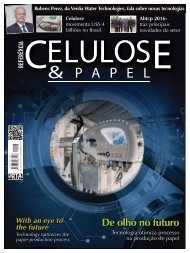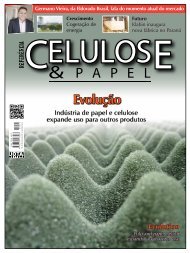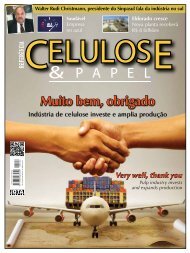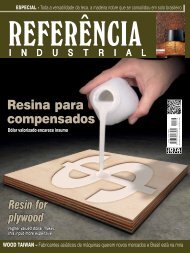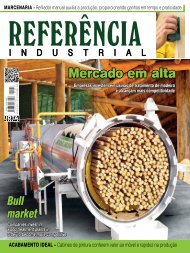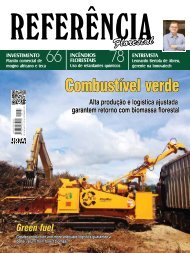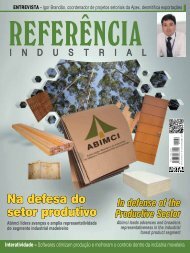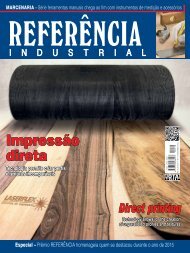You also want an ePaper? Increase the reach of your titles
YUMPU automatically turns print PDFs into web optimized ePapers that Google loves.
A R T I G O<br />
INTRODUÇÃO<br />
INTRODUCTION<br />
Uma das particularidades do desenvolvimento<br />
de projetos na área<br />
florestal é a necessidade de considerar<br />
períodos extensos entre o<br />
estabelecimento de um plantio e<br />
seu aproveitamento final. Empreendimentos<br />
industriais cuja matéria-prima provém<br />
de bases florestais estão, portanto, sujeitos a programas<br />
de abastecimento que dependem fundamentalmente<br />
de prognósticos. Anos de pesquisas<br />
e desenvolvimento de modelos de prognose permitem<br />
atualmente estimar, com razoável precisão,<br />
produções futuras de talhões ou grupos de talhões.<br />
Essas estimativas são essenciais para o planejamento<br />
adequado das atividades florestais.<br />
No entanto, ordenar extensos povoamentos<br />
florestais visando suprimentos futuros constantes<br />
e sustentáveis ainda remanesce como uma prática<br />
desafiadora. Considerando-se que os custos de<br />
produção, colheita e transporte da matéria-prima<br />
empregada resultam em uma parcela significativa<br />
do custo do produto final, é determinante a necessidade<br />
de se otimizarem os meios pelos quais é<br />
possível reduzir o desembolso com a sua produção<br />
e/ou aquisição, principalmente em se tratando de<br />
grandes volumes anuais. O planejamento florestal,<br />
confrontado com um universo variado de possibilidades,<br />
pode se beneficiar das metodologias de otimização<br />
via programação linear para gerar modelos<br />
que permitam uma análise simultânea de todos<br />
os recursos, prescrevendo a melhor linha de ações<br />
ou orientando em direção à melhor alternativa.<br />
Fábricas de papel e celulose normalmente possuem<br />
uma mesma necessidade: a de administrar<br />
o consumo de grandes quantidades anuais de matéria-prima.<br />
A matéria prima – no caso específico<br />
estudado neste trabalho, madeira de reflorestamentos<br />
de<br />
Eucalyptus spp – provém de fontes bastante<br />
diversas. De forma geral, as fontes são: áreas próprias,<br />
áreas de terceiros com vínculos contratuais<br />
com a empresa (parcerias florestais e programas de<br />
fomento) e mercado livre. Essa diversidade de fon-<br />
O<br />
ne of the particularities in carrying<br />
out projects in forest areas is the<br />
need to consider the long period<br />
between the establishment of a<br />
plantation and making use of the<br />
end product. Therefore, Industrial enterprises<br />
whose raw material comes from a forest base are<br />
subject to supply programs that fundamentally<br />
depend on prognoses. Years of research and development<br />
on prognostic models have currently<br />
made it possible to make estimates, with reasonable<br />
accuracy, for future production from stands or<br />
groups of stands. These estimates are essential for<br />
the proper planning of forestry activities.<br />
However, managing extensive forest stands<br />
aimed at a constant and sustainable future supply<br />
still remains a big challenge. Considering that<br />
production, harvesting and raw material transport<br />
costs are a significant portion of the cost of the<br />
final product, it is crucial to optimize the means<br />
by which it is possible to reduce raw material production<br />
and/or acquisition costs, especially when<br />
it comes to large annual volumes. Forest planning,<br />
confronted with a varied universe of possibilities,<br />
can benefit from the use of optimization methodologies,<br />
such as linear programming, to generate<br />
models that allow a simultaneous analysis of all resources,<br />
indicating the best line of actions or providing<br />
the direction of the best alternative.<br />
Pulp and paper mills typically have the same<br />
need: to administer the annual consumption of<br />
large quantities of raw material. The raw material<br />
– in particular the case studied in this work, wood<br />
from Eucalyptus spp. replanted forests –comes<br />
from quite different sources. In general, the sources<br />
are: areas owned by companies, areas with<br />
contractual links to a third party (forest outgrower<br />
partnerships and programs), and the free market.<br />
This diversity of sources is also reflected in the several<br />
costs relative to each, since these vary according<br />
to a number of factors related to each, such<br />
as the planting and maintenance methods used,<br />
the type of harvest, the average transport distance,<br />
38


